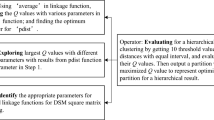Abstract
Modular technology can effectively support the rapid design of products, and it is one of the key technologies to realize mass customization design. With the application of product lifecycle management (PLM) system in enterprises, the product lifecycle data have been effectively managed. However, these data have not been fully utilized in module division, especially for complex machinery products. To solve this problem, a product module mining method for the PLM database is proposed to improve the effect of module division. Firstly, product data are extracted from the PLM database by data extraction algorithm. Then, data normalization and structure logical inspection are used to preprocess the extracted defective data. The preprocessed product data are analyzed and expressed in a matrix for module mining. Finally, the fuzzy c-means clustering (FCM) algorithm is used to generate product modules, which are stored in product module library after module marking and post-processing. The feasibility and effectiveness of the proposed method are verified by a case study of high pressure valve.
Similar content being viewed by others
References
CHUNG W H, KREMER G E O, WYSK R A. A modular design approach to improve product life cycle performance based on the optimization of a closed-loop supply chain [J]. Journal of Mechanical Design, 2013, 136(2): 165–173.
MCADAMS D A, STONE R B, WOOD K L. Functional interdependence and product similarity based on customer needs [J]. Research in Engineering Design, 1999, 11(1): 1–19.
STONE R B, WOOD K L, CRAWFORD R H. A heuristic method for identifying modules for product architectures [J]. Design Studies, 2000, 21: 5–31.
DAHMUS J B, GONZALEZ-ZUGASTI J P, OTTO K N. Modular product architecture [J]. Design Studies, 2001, 22(5): 409–424.
BRYANT C R, SIVARAMAKRISHNAN K L, van WIE M, STONE R B, MCADAMS D A. A modular design approach to support sustainable design [C]// ASME 2004 International Design Engineering Technical Conferences and Computers and Information in Engineering Conference. Salt Lake City: American Society of Mechanical Engineers, 2004: 909–918.
KRENG V B, LEE T P. QFD-based modular product design with linear integer programming—A case study [J]. Journal of Engineering Design, 2004, 15(3): 261–284.
ERICSSON A, ERIXON G. Controlling design variants: Modular product platforms [M]. New York: ASME Press, 1999.
GU P, SOSALE S. Product modularization for life engineering [J]. Computer Integrated Manufacturing, 1999, 15(5): 387–401.
SAND J C, GU P, WATSON G. HOME: House of modular enhancement-tool for modular product redesign [J]. Concurrent Engineering Research & Applications, 2002, 10(2): 153–164.
YU Sui-ran, YANG Qing-yan, TAO Jing, TIAN Xia, YIN Feng-yu. Product modular design incorporating life cycle issues-Group genetic algorithm (GGA) based method [J]. Journal of Cleaner Production, 2011, 19(9): 1016–1032.
TSENG H E, CHANG C C, LI J D. Modular design to support green life-cycle engineering [J]. Expert Systems with Applications, 2008, 34(4): 2524–2537.
UMEDA Y, FUKUSHIGE S, TONOIKE K, KONDOH S. Product modularity for life cycle design [J]. CIRP Annals -Manufacturing Technology, 2008, 57(1): 13–16.
KRENG V B, LEE T P. Modular product design with grouping genetic algorithm—A case study [J]. Computers & Industrial Engineering, 2004, 46(3): 443–460.
SMITH S, YEN C C. Green product design through product modularization using atomic theory [J]. Robotics and Computer-Integrated Manufacturing, 2010, 26: 790–798.
WANG Hai-jun, ZHANG Qiang, YUE Tong-qi. Process analysis in the generation of product modularization based on fuzzy cluster [C]// Proceedings of 8th International Conference on Computer Supported Cooperative Work in Design-Processing. Xiamen: IEEE, 2004: 521–525.
LI Jian-zhi, ZHANG Hong-chao, GONZALEZ M A, YU S. A multi-objective fuzzy graph approach for modular formulation considering end-of-life issues [J]. International Journal of Production Research, 2008, 46(14): 4011–4033.
QIAN Xue-qing. Environment analysis model for modular design of electromechanical products [D]. Lubbock: Texas Tech University, 2003.
QIAN Xue-qing, ZHANG Hong-chao. Design for environment: An environmentally conscious analysis model for modular design [J]. IEEE Transactions on Electronics Packaging Manufacturing, 2009, 32(3): 164–175.
NEPAL B, MONPLAISIR L, SING N. A methodology for integrating design for quality in modular product design [J]. Journal of Engineering Design, 2007, 17(5): 387–409.
ZHOU De-xin, LI Wei. Research method of circuit fault diagnosis based on FCM [J]. Journal of Central South University, 2009, 40(suppl 1): 290–294.
CHEN Pin, YANG Wen-yu. Modular clustering of complex product structure and quantity of design iteration calculation [J]. China Mechanical Engineering, 2007, 18(11): 1346–1349.
Author information
Authors and Affiliations
Corresponding author
Additional information
Foundation item: Project(51275362) supported by the National Natural Science Foundation of China; Project(2013M542055) supported by China Postdoctoral Science Foundation Funded
Rights and permissions
About this article
Cite this article
Lei, Ty., Peng, Wp., Lei, J. et al. A product module mining method for PLM database. J. Cent. South Univ. 23, 1754–1766 (2016). https://doi.org/10.1007/s11771-016-3229-3
Received:
Accepted:
Published:
Issue Date:
DOI: https://doi.org/10.1007/s11771-016-3229-3




